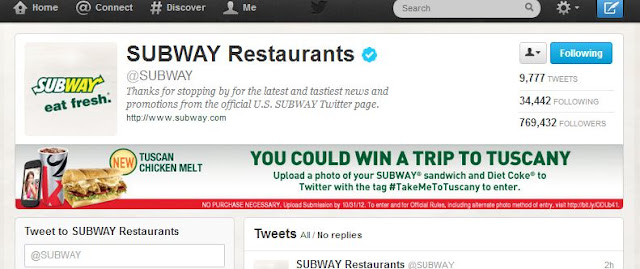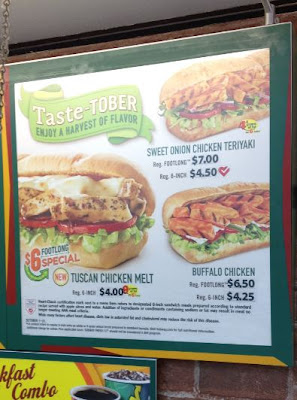Multichannel marketing is defined as the use of many
different marketing channels to reach a customer. Better than multichannel marketing is
omnichannel marketing which is using one-upping multichannel marketing and
linking several channels together to form a cohesive message. These terms and definitions are simple
enough and have been on the front of marketers’ minds for several years. Why though is it still not practiced as
cohesively as it could be, specifically in the quick-service restaurant (QSR) world? In fact it is so rare in QSR’s that I find
it refreshing when it is practiced well.
Thinking about this, I did a check-up on a few QSR’s. One chain that stood out as a great example
is Subway. They are doing a stellar job promoting
their latest limited time offer, the Tuscan Chicken Melt. Here are several of my observations about
what I feel they are doing right.
 |
| Web page |
On the web, Subway effectively captures the attention of the
visitor by splashing the Tuscan Chicken Melt front-and-center on within seconds
of opening the web page. They also
effectively engage visitors by throwing out a brief teaser to the promo (above)
before the heart of the promo is shown on the web (below).
 |
| Web page |
Thirdly, Subway encourages additional engagement with the
promo by offering a reason to engage with it and the brand by offering a grand prize of a trip to Tuscany,
Italy. Clicking on the circled icon
takes the visitor to a second marketing channel, Twitter. Here, visitors are encouraged to upload a
photo of the sandwich, along with a Diet Coke and use a Twitter hashtag to
enter the contest.
 |
 |
On these three channels
- the web, Facebook and Twitter - Subway clearly does a superb job. But
the real test was still to come as I had yet to visit restaurant in person –
and this is where I find most restaurants fall short. (I’ll get to why in a
bit.) So, I drove to my local restaurant
and, as I pulled in to a parking space, I noticed that they were off to a good
start: front-and-center, looking right at me, was a large window decal
announcing the Tuscan Chicken Melt.
 |
| Window Decal |
As I walked into the restaurant, I was equally impressed with
several pieces of POP signage advertising the Tuscan Chicken Melt: on the tops
of tables, by the register, above the chips basket, on the beverage cooler and
on the menu board.
 |
| Chips basket |
 |
| Menu Board |
Based on this evidence Subway clearly did a great job of
promoting the Tuscan Chicken Melt through multiple channels. They also
connected the dots for omnichannel marketing as they gave customers an
incentive to engage with the promotion on all of the above channels. Not only that, but the visual of a smart or
cell phone in several pieces gave visual clues about how to register for the
Twitter contest.
Let’s revisit the earlier question; why do many QSR’s successfully
promote their offerings on all channels except the most important one (at-store)?
I have found that when corporate
marketing seeks to get approval for at-store pieces, the process often becomes
mired in cumbersome processes taking eight weeks or more, when it should be a
one-month turnaround from idea creation to having signage at-store. For that reason, many marketers throw up
their hands in frustration and they end up refusing or not promoting specials
well at-store.
But it doesn’t have to be this way: as there is a solution. Read more
about this on the links below:
QSR marketers, are you effectively promoting your offerings, using
all available channels, and are they all tied together to form a cohesive,
unified, and engaging message? If not,
what is hindering you from doing this?
